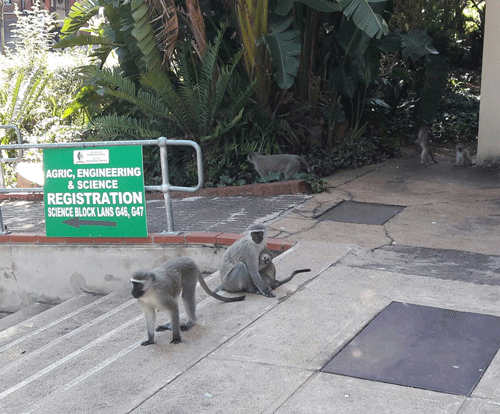Building resilient cities: the case of primates in urban areas
|
|
Monkeys in urban areas. Photo credit: Benis Egoh. |
By Benis Egoh
Council for scientific and Industrial Research, 11 Jan Cilliers Street, Stellenbosch, 7600, South Africa; Centre for Tropical Research, Institute of the Environment and Sustainability, University of California, Los Angeles, Charles E. Young Dr. East 619, 90095, Los Angeles, CA, USA
Primates are regarded as nuisance wildlife in urban areas of South Africa, Kenya, and Eritrea, and consumed as bushmeat in Cameroon, Gabon and Madagascar. Therefore, they evoke a range of attitudes from the local communities that influence their conservation priorities.
Thirteen monkeys were recently poisoned in Hibberdene, a coastal town of KwaZulu-Natal. The incident sparked a series of debates on this issue, and if monkeys should be relocated back to wilderness areas or left within the city. The negative attitudes arise because monkeys cause injuries to people, raid bird nests to eat eggs and fledglings, and destroy gardens. Indeed, vervet monkeys are known in South Africa for raiding crops, orchards and even human dwellings, causing high conflicts with residing communities.
Many cities in Africa enjoy nature’s bounty. Food gardens have taken off in the city of Durban, which benefit from pollination services from nearby natural areas. Studies have shown that wild bees in urban areas can support adequate pollination service to urban agriculture, producing significantly more fruits than artificial pollination (Potter and LeBuhn, 2015). So, how do we plan cities to be resilient to conflicts between human and nature but also in providing much needed ecosystem services such as pollination?
Cities have visions, some of which can be implemented by spatial planning. Balancing infrastructure development of roads and housing with environmental goals such as keeping open spaces and low levels of pollution for a safe city is of the essence. According to Anderson et al. (2014) urban planning strategies often fail to acknowledge ecological and social synergies in cities. Cities hold potential for new urban spatial designs that integrate ecosystem services in the built environment. In South Africa, the spatial development framework (SDF) is widely used to implement a city’s vision. For example, the Durban Metropolitan Open Space System (D’MOSS) is an important input into the municipality’s SDF which caters to the biodiversity. These planning tools offer opportunities to improve a city’s resilience by enhancing the provision of ecosystem services while limiting disservices. For example, Saj et al. (2003) found that the distance of properties from the forest edge is an important factor influencing the crop-raiding activities of vervet monkey’s in Uganda. Indeed, gardens that were 200 m from the forest edge received significantly less crop-raiding than those located 100 m away. Similarly, distances between open spaces could be investigated for crop pollination when planning for open spaces in cities. This type of information could make a difference if integrated into the city’s spatial planning and improve resilience.
Biggs et al. (2015) have outlined seven principles of resilience that are important in the delivery of ecosystem services and relevant to city planning. It is important to maintain diversity to benefit from the different functions and associated services such as pollination and dispersal which different species provide. Connectedness between patches of vegetation or open natural spaces in the city ensures that species can move between patches, giving them the opportunity to interact and reproduce, but also it creates refugia when conditions become unbearable in one part. According to Biggs et al. (2015), principles of resilience must be applied on a selected set of ecosystem services (e.g. aesthetic value, recreation or pest control) based on relevance to the society at large.
Cities differ with their experiences, expectations and vision, but it’s the governance systems that make or mar them. It is imperative to understand the contexts, past experiences and the challenges faced by the cities while designing and implementing spatial plans. This will need the involvement of stakeholders from different sectors and a continuous process of adapting to change.
Acknowledgement: This work is carried out within GRAID, a programme funded by the Swedish International Development Cooperation Agency (Sida).
References
Andersson, E., Barthel, S., Borgström, S., Colding, J., Elmqvist, T., Folke, C. and Gren, Å., 2014. Reconnecting cities to the biosphere: stewardship of green infrastructure and urban ecosystem services. Ambio, 43(4), pp.445-453.
Biggs, R., Schlüter, M. and Schoon, M.L. eds., 2015. Principles for building resilience: sustaining ecosystem services in social-ecological systems. Cambridge University Press.
Potter, A. and LeBuhn, G., 2015. Pollination service to urban agriculture in San Francisco, CA. Urban ecosystems, 18(3), pp.885-893.
Saj, T.L., Sicotte, P. and Paterson, J.D., 2001. The conflict between vervet monkeys and farmers at the forest edge in Entebbe, Uganda. African Journal of Ecology, 39(2), pp.195-199.
